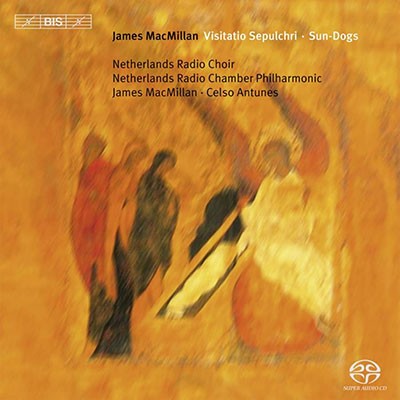Visitatio Sepulchri
(1992-93)Texts from a 14th century Easter Day liturgical drama and the Te Deum (L)
2S,A,2T,B,male speaker (Sprechstimme)
2(II=picc).2(II=corA).2(II=bcl).2(II=dbn)-2.2.2(II=btrbn).0-timp.
perc(1):2cowbells/2wdbl/2bongos/2timbales/SD/2tam-t/5tom-t/
5tpl.bl/glsp/t.bells/BD/cyms/bell tree-strings(min:8.6.4.4.2)
NB: this work is available both as a music theatre piece and for
concert performance
Abbreviations (PDF)
Boosey & Hawkes
Visitatio Sepulchri is a setting of a fourteenth century liturgical drama from Notre Dame Cathedral in Paris. Originally it would be enacted during Matins on Easter Sunday morning when members of the clergy and choir would take the part of the three angels and three women.
On finding the tomb empty and open on Easter morning the three women encounter three angels at the entrance to the supulchre "Whom do you seek?" the angels enquire. "Jesus of Nazareth" the women answer. "He is not here, he has risen from the dead as predicted. Go and tell this to the world." Women, angels and cantor then join in the Easter sequence ‘Victimae Pascheli laudes’ which is followed by the ‘Te Deum’.
As an opera libretto this text is entirely anti-dramatic but my initial inspiration was sparked by its starkness, objectively and minimal theatricality. The drama became internalised in the music with multi-layered intensity, while the simplicity in the text, with its lack of narrative, gives a blank sheet to the producer. My intention was that the visual complement to the music should be as ritualistic as possible, absorbing, deconstructing and reconstituting the liturgical actions of Holy Week as an extra layer of movement and activity about music and text.
The work is in three sections. The opening scene is entirely without text – a lengthy orchestral prelude which captures the violence of the crucifixion, the anguish and the agony at Golgotha. Scene Two includes the dialogue between the women and the angels when the story of the Resurrection is relayed for the first time. A seventh character makes his appearance here; the Cantor provided a central function in ecclesiastical liturgy and here he acts as a ‘representative’ of the onlookers in this sacred drama. He is the only figure who does not ‘sing’ – he speaks, shouts and chants in sprechstimme style and he interjects questions, comments and exclaimes as if from the multitude outside.
The final section is a rendition of the great hymn of praise Te Deum (We praise you, O God) and represents both the culmination of the Easter story and the celebration of Resurrection. Musically, this scene is devised so that a number of ideas are kept in motion at all times, in different layers, coming back again and again in different guises, giving the impression of the same huge cyclical pattern of inevitability revolving at different times, speeds and levels throughout the voices and orchestra.
James MacMillan, April 1993
Reproduction Rights
This programme note can be reproduced free of charge in concert programmes with a credit to the composer
Choral level of difficulty: Level 5 (5 greatest)
This work is one of a number by MacMillan that can be presented in a number of formats: fully staged as at its premiere, in a music theatre style with simple lighting, or as a purely concert work. Orginally performed with solo voices, MacMillan recast the work for seven-part choir, each choral section taking one of the solo parts. Visitation Sepulchri dates from the time the composer first burst onto the musical scene with works such as The Confession of Isobel Gowdie and Veni, Veni, Emmanuel, and shares their blending of energy, passion and reflection.
In biblical terms it moves on from where his St John Passion ends as it is concerned with the women’s visit to the sepulchre where Jesus’ body has been laid following his crucifixion. Scene One is a purely orchestral, powerfully moving scene-setter mirroring the drama of the crucifixion. Scene Two introduces three angels (TTB), the three women (SSA) and a male Cantor section which sings/speaks/shouts un-notated, approximate pitch throughout (rather like sprechstimme). The extreme contrasts between the still, reflective meditations of the singers and the dramatic brass-dominated interjections from the orchestra seem to reflect an outward prayerfulness and inward turbulence following the Angels’ confirmation of Jesus’ resurrection. Scene Three follows without a break and is a setting of the Te Deum. This is complex and incredibly energised. The winding-down process sees a statement of the plainsong Te Deum melody used effectively in long notes against a still hyperactive orchestra. At the end of the text, ‘let me never be confounded’, the music moves into an extraordinarily different mode – almost cinematic in its triumph and consolation which might follow the successful resolution of the plot of a thriller. The voices whisper a fade-out.
This remarkable score is complex and needs highly skilled singers with, in some cases, fairly extreme ranges: the 1st tenors have to touch a top D flat at one point and the 3rd Angel (basses) begins the second scene on low Es. The orchestral writing is often virtuoso and the whole work will, of course, need to generate theatrical electricity whether performed staged or in concert. MacMillan’s deep feeling for religious drama is one of the things which sets him apart from almost all his composer colleagues working at this level.
Repertoire note by Paul Spicer
"This work is quintessential MacMillan. It progresses relentlessly from spaciously looming towers of string tone to outbursts of terror... the strength of feeling is irresistible; bursting with love, pain and tenderness..."
Opera

Netherlands Radio Choir / Netherlands Radio Chamber Philharmonic / James MacMillan
BIS SACD 1719

